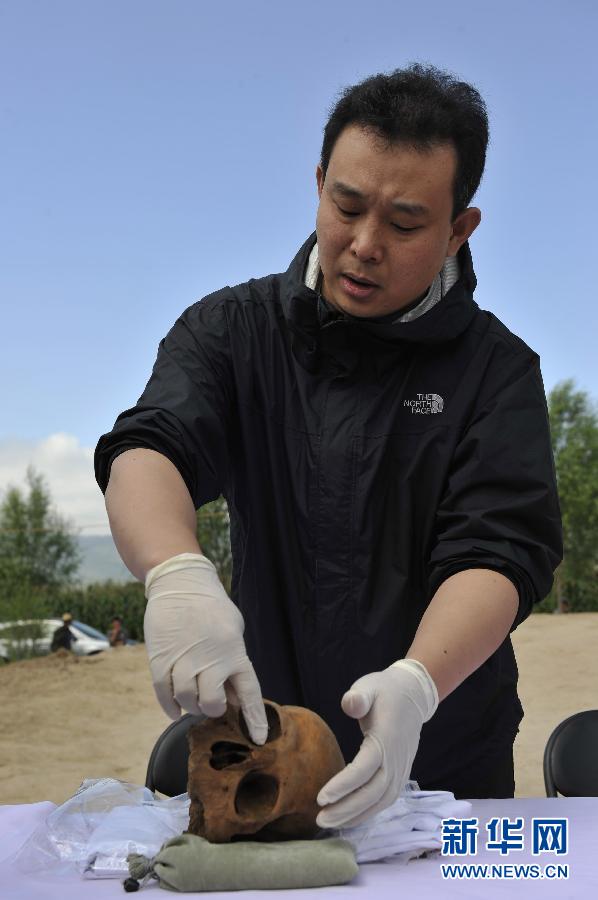A Westerner in Early Medieval China? September 5, 2014
Author: Beach Combing | in : Medieval , trackbackHere is a story that has come out of the Chinese media in the last few days and that has been little noticed in the west, certainly it has been little discussed. The reports are unsatisfactory in all kinds of ways. But the bare bones of information includes the following: in M1401, an early medieval (in European terms) tomb in Guyuan City in North-Western China, part of a skull has been discovered. This skull has been judged to be ‘western’.
This begs all kinds of questions. First in what way is the skull associated with the tomb: was it one of several or was it the remains of the principal tenant? Second, how do we know the skull is western? One professor involved in the dig has gone on the record as saying: ‘The man had a protruding nasal bone and a sunk nasion, which are typical features of Europeans’. Beach is not a biologist, an archaeologist or a sinologist, but the first part of the sentence sounds dangerously like Europeans have big noses, therefore… See the picture. Third, what is meant by ‘European’ given that, from the Tarim Mummies onwards, many Caucasian individuals are to be found in western China and many Caucasians hold Chinese passports today? Can anyone help with these points? Drbeachcombing AT yahoo DOT com
But leaving aside these doubts and questions – and Chinese archaeology has professionalized dramatically in the last generation – how strange would it be to find a European in Guyan in the seventh, eighth or ninth century? Well, Guyan was on the Silk Road and silk continued to run through to the Mediterranean in this period, even as the Persians and Byzantines were learning how to make it themselves. Then there is also the implication that silk may have come directly up the great rivers that make the borders of Europe, particularly the Volga, into the Baltic: there is good evidence for a Viking taste for silk. We know too little about the intermediaries between these two worlds: we cannot trace how these goods passed backwards and forwards, a process that is shadowy in the much better documented Roman period. But there were clearly caravans and it is likely that some people of Caucasian type passed backwards and forwards along these routes: again this is not as dramatic as it may seem given that ‘Caucasian’ types are found deep into Asia. There is so much that is exciting in those fleeting contacts between east and west, but Beach would not like to build even a mud hut’s foundations on the big-nosed skull from M1401, at least not without more information.
24 Sept 2014: ANL writes: You point out that “there is also the implication that silk may have come directly up the great rivers that make the borders of Europe, particularly the Volga, into the Baltic: there is good evidence for a Viking taste for silk.” Silk has been found in quite a few tombs of the Hallstatt culture (8th to 6th century BC), so this is nothing new, and it probably followed the same route up the Danube.
26 Oct 2014: Thanks to Hans, over at MongolsChinaAndTheSilkRoad, who drummed up some more interest in this story and get a reaction from Ursula Sims-Williams of the British Library. As suggested above, there is a crucial distinction between Caucasian and Western. ‘I was lucky enough to be at the site in Guyuan on the day the press interview took place, but never heard mention of any ‘Westerners’ or ‘Europeans’.’Caucasian’ was suggested as a possibile origin for the skull. Bearing in mind the proximity of the tombs of the SOGDIAN Shi family, the likelihood is that the tomb and skull belong to a Sogdian trader. This seems to be a case of mistranslation from Chinese! There is a whole chapter on the Shi family tombs at Guyuan by Luo Feng in the exhibition catalogue Monks and Merchants, ed. Annette Juliano and Judith Lerner (Asia Society, 2001), pp.239-269. For online referenceas, see Étienne de la Vaissière’s article ‘Sogdians in China: a short history and some new discoveries’ (http://bit.ly/1wc82VO).’ Thanks Hans and, at a distance, Ursula.
Bruce T, 23 Feb 2017: The obvious candidate in that time and at that place, roughly the eastern terminus of the the overland Silk Route, would be a Radhanite merchant from the lands around the Mediterranean, possibly their base in the far west, southern France. The Radhanites, Jewish merchants, were the main importers of Eastern luxury products into the West in the early Medieval period. They traveled to and from China via both the overland steppe route, and by sea, leaving from either Jeddah in the Hijaz or from Basra at the head of the Persian Gulf. They were known to be active from the 6th through the early 10th century CE., the time period of the skull. In fact the Jewish community in Ningxia, the name of the Autonomous Region Guyuan is located in sent new Torah’s to the Jew’s of Kaifeng hundreds of miles to the east after a flood wiped out their synagogues in the 11th cen. CE. The Jewish community in Kaifeng has been there since the time of the Han, according to Chinese records, analogous to the period of the Pax Romana in the West. The Radhanites were going to China regularly in the proper period, they were Westerners, and the skull was found in a terminus city on the overland Silk Route with an established Jewish presence in the period. Logic and facts seem to point to the skull being that of someone belonging to the local Rhadanite/Jewish merchant community or recent arrival of the same from the West.



